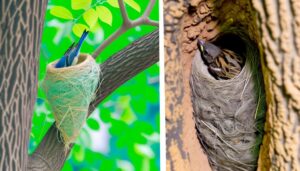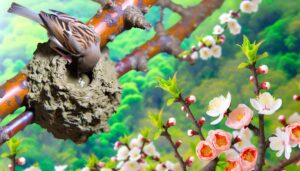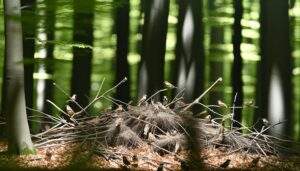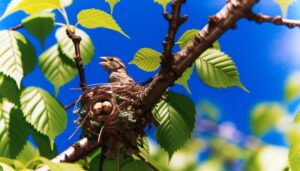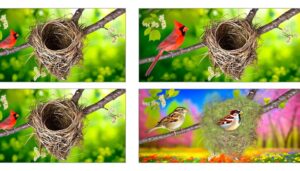Do Barn Sparrows Come Back to Their Nest?
Yes, barn sparrows often come back to their nests. They exhibit strong nest site fidelity, meaning they consistently return to the same nesting locations each breeding season.
Their remarkable homing instincts, utilizing the Earth's magnetic field and visual landmarks, guide them back accurately. By reusing and refurbishing old nests, sparrows conserve energy and time, enhancing their breeding success.
This behavior guarantees greater survival rates of their offspring and contributes to stable populations. Explore how their nesting habits and environmental adaptations play an important role in their life cycle.
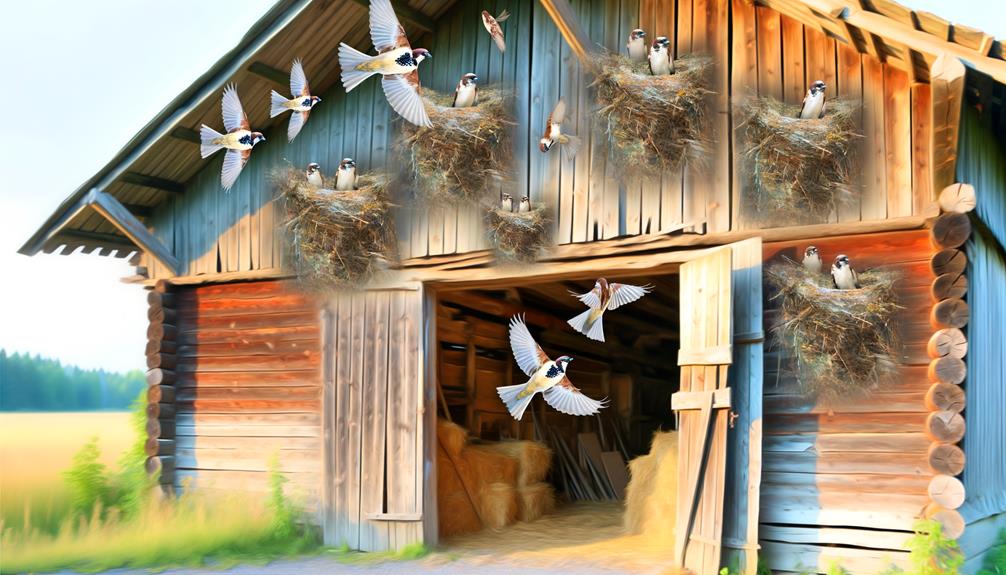
Key Takeaways
- Barn sparrows exhibit strong nest site fidelity, returning to the same nesting locations each season.
- They reuse and refurbish old nests, showing a preference for familiar sites.
- Returning to previous nests enhances breeding success by minimizing energy spent on finding new sites.
- Their remarkable homing instinct helps them navigate back to prior nesting areas.
- Nest site fidelity contributes to stable populations and effective reproduction.
Barn Sparrow Nesting Habits
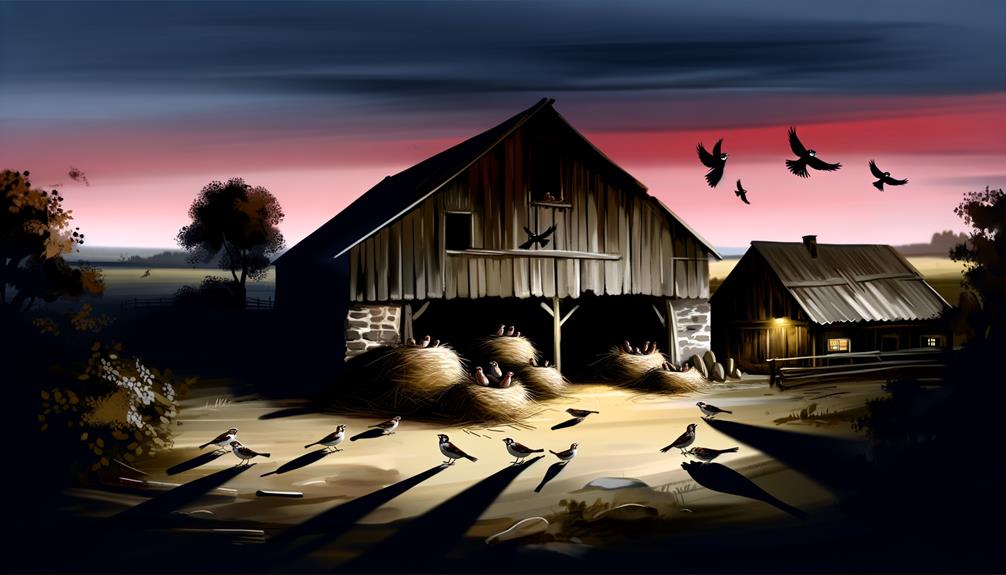
Barn sparrows exhibit meticulous nesting habits, often choosing to build their nests in sheltered locations such as barn rafters or under eaves. You'll notice they prefer these spots for protection from predators and harsh weather.
Their nests are constructed using a mix of twigs, grass, and feathers, creating a sturdy and insulated structure. Observations show that both male and female sparrows participate in gathering materials and building the nest. It's fascinating to see their teamwork and dedication.
Studies indicate that these birds often reuse and refurbish old nests, demonstrating resourcefulness and efficiency. By understanding their nesting behaviors, you can take steps to protect their habitats, ensuring these industrious birds continue to thrive in your community.
Migration Patterns
You should observe that barn sparrows follow well-defined seasonal travel routes, often covering thousands of miles between breeding and wintering grounds. Their strong nesting site fidelity means they frequently return to the same location each year, demonstrating remarkable navigational abilities.
Environmental influences such as climate changes and food availability notably impact their migration patterns, as evidenced by recent tracking studies.
Seasonal Travel Routes
Researchers have meticulously mapped the barn sparrows' seasonal migration routes, revealing a complex network of travel paths that spans thousands of miles.
You'll find that these routes aren't random; they're influenced by factors like weather patterns, food availability, and geographic barriers.
Data from satellite tracking and banding studies show that barn sparrows travel from North America to Central and South America during winter months. This long-distance migration guarantees they access resources essential for survival.
By understanding these patterns, you can better appreciate the challenges barn sparrows face and the importance of preserving their habitats along these routes.
Your efforts in conservation can support these remarkable birds' journeys, ensuring their safe travel and successful return.
Nesting Site Fidelity
Through detailed observation and satellite tracking, you'll find that barn sparrows exhibit a remarkable fidelity to their nesting sites, often returning to the same location year after year. Research indicates that these birds use environmental cues and possibly even geomagnetic fields to navigate back to their previous nesting spots.
In one study, over 90% of barn sparrows returned to their original nesting sites after migration. This consistency suggests that barn sparrows have a strong attachment to their chosen sites, enhancing their breeding success. By understanding these patterns, you can better support conservation efforts, ensuring that these birds continue to thrive.
Your efforts to maintain and protect these nesting sites contribute significantly to sustaining barn sparrow populations.
Environmental Influences
While barn sparrows display a strong loyalty to their nesting sites, their migration patterns are intricately influenced by various environmental elements such as temperature, food availability, and seasonal changes. You'll notice that when temperatures drop, sparrows tend to migrate to warmer regions where food is more abundant. Seasonal changes also play a significant role, as sparrows adjust their migration timing to achieve optimal breeding conditions.
| Environmental Element | Influence on Migration |
|---|---|
| Temperature | Move towards warmer regions |
| Food Availability | Relocate to food-rich areas |
| Seasonal Changes | Adapt migration timing |
| Weather Patterns | Avoid adverse conditions |
This nuanced behavior highlights how barn sparrows adapt to their environment, ensuring their survival and ability to serve their ecosystem by maintaining balanced insect populations.
Homing Instinct
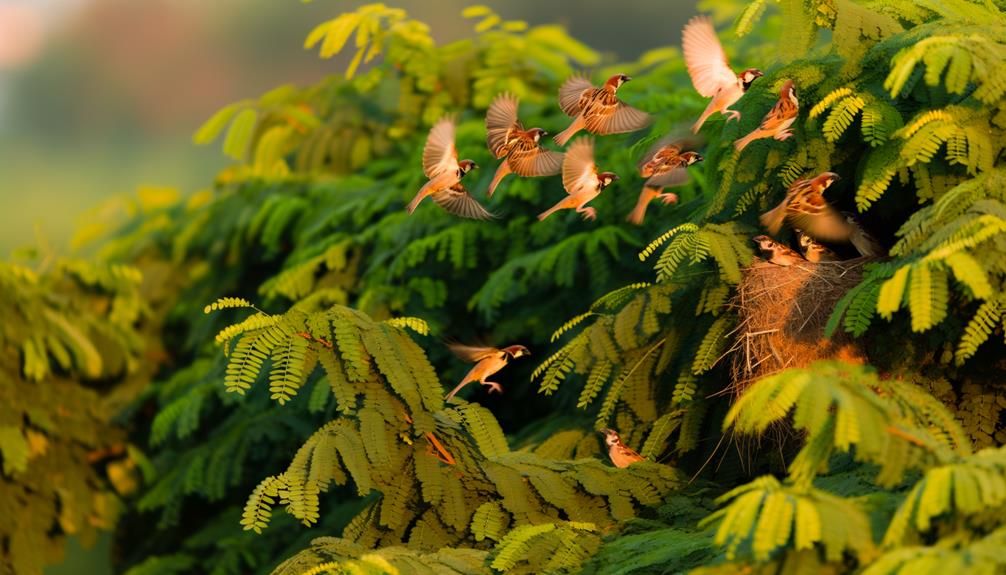
How do barn sparrows manage to navigate vast distances and return to the exact location of their nest year after year? They possess a remarkable homing instinct, a blend of genetic and learned behaviors.
Studies show that barn sparrows use the Earth's magnetic field as a navigational guide. They also rely on visual landmarks and the position of the sun. Research indicates that their brains are wired to store detailed maps of their migration routes. By combining these cognitive maps with innate magnetic sensitivity, barn sparrows consistently find their way back.
This precise navigation reflects their evolutionary adaptation, ensuring they can care for their young and maintain their nesting sites. Understanding this homing instinct can inspire innovative solutions in fields like navigation and conservation.
Nest Site Fidelity
Barn sparrows not only exhibit a remarkable homing instinct but also display strong nest site fidelity, consistently returning to the same nesting locations year after year. This behavior has been documented through banding studies, which show that individual sparrows often return to previously used nests.
You'll find that this fidelity enhances their breeding success by minimizing the energy spent on locating new sites and building nests. Additionally, familiar sites offer known resources and reduced predation risks.
Observations confirm that sparrows' site fidelity contributes to stable populations and effective reproduction. By recognizing and supporting these patterns, you can better contribute to conservation efforts, ensuring these birds have the continuous opportunity to thrive in their preferred environments.
Seasonal Nesting Behaviors
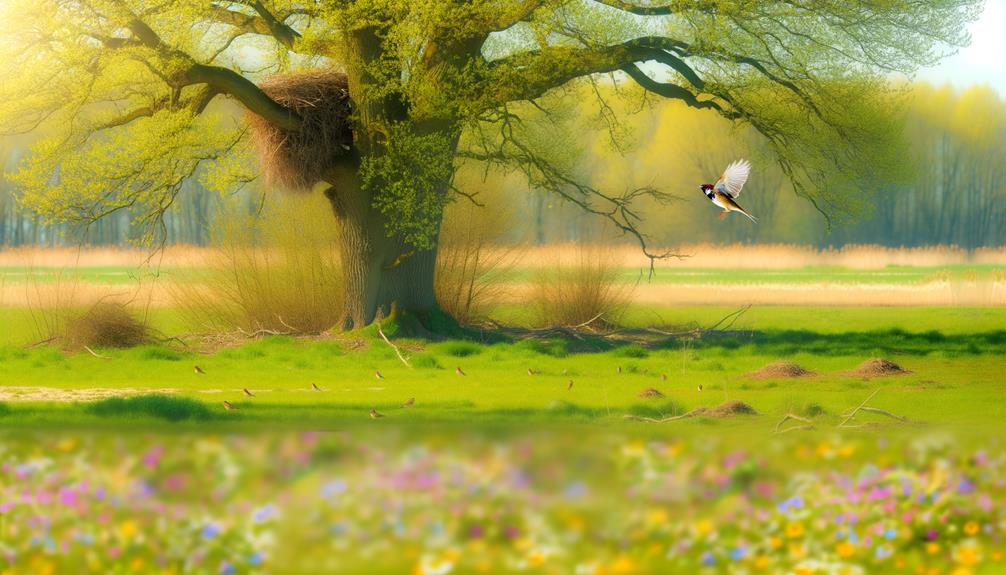
Each spring, barn sparrows initiate their nesting activities, driven by increasing daylight and rising temperatures. You'll notice these small, industrious birds returning to familiar sites, carefully inspecting and repairing their nests. The process is meticulous and efficient, as they prepare for the new breeding season. Observing their behaviors provides valuable insights into their complex social structures and reproductive strategies.
Research shows that barn sparrows exhibit remarkable consistency in their nesting patterns:
- Renewed bonds: Witness the touching reunions between mated pairs.
- Vigilant care: See parents tirelessly feeding their chicks.
- Community spirit: Observe how they defend their nests from predators.
- Nature's cycle: Feel the anticipation of life's renewal.
- Hope: Be inspired by their resilience and determination.
These behaviors highlight the sparrows' dedication to their offspring's survival.
Environmental Influences
Curiously, environmental conditions such as temperature fluctuations, availability of resources, and habitat quality profoundly impact barn sparrows' nesting success and reproductive behaviors. You'll find that sparrows adapt their nesting based on these conditions to enhance survival and reproductive success.
| Environmental Factor | Impact on Nesting | Observational Evidence |
|---|---|---|
| Temperature Fluctuations | Alters nesting timing | Earlier nesting in warmer springs |
| Resource Availability | Affects clutch size | More food leads to larger clutches |
| Habitat Quality | Influences nest location | Preference for safer, sheltered sites |
These factors drive sparrows to select ideal nesting sites, ensuring both immediate and future reproductive success. By understanding these influences, you can better support and protect their habitats, fostering a thriving sparrow population.
Predation and Nesting
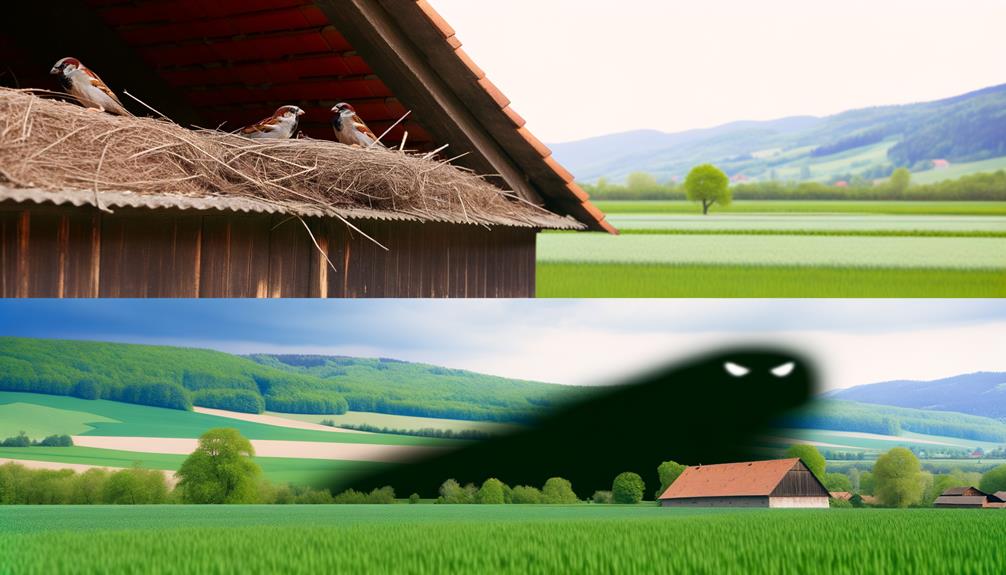
When observing barn sparrows, you'll notice that common nest predators include snakes, cats, and larger birds.
Sparrows employ various nest defense strategies like mobbing and alarm calling to protect their offspring.
Studies show that these tactics greatly influence their nesting success by reducing the likelihood of predation.
Common Nest Predators
Barn sparrow nests face significant threats from predators such as snakes, cats, and larger birds, which can dramatically impact their breeding success. Observations reveal that these predators often target eggs and young chicks, reducing the sparrows' chances of raising their offspring to adulthood. The presence of predators can cause significant stress and nest abandonment.
You might be surprised by the emotional toll this takes:
- Helpless chicks falling prey to stealthy snakes.
- Family units disrupted by prowling cats.
- Fragile eggs shattered by larger birds.
- Anxiety in parent sparrows witnessing predation.
- Lost generations of sparrows due to predation.
Understanding these threats helps us better protect these delicate creatures and their nests, fostering a safer environment for barn sparrows to thrive.
Nest Defense Strategies
Implementing various nest defense strategies is essential for barn sparrows to enhance their breeding success and reduce the impact of predation.
You'll notice that these birds engage in aggressive behaviors, such as mobbing, where multiple sparrows collectively harass potential predators.
They also strategically select nesting sites in less accessible locations, often in human structures like barns, which provide added protection.
Evidence shows that barn sparrows frequently use alarm calls to alert other birds of nearby threats, enhancing communal vigilance.
By choosing nesting materials that blend with their surroundings, they increase camouflage, making nests harder to spot.
These detailed observations underscore the effectiveness of these defense strategies in safeguarding their offspring and ensuring the continuity of their species.
Impact on Nesting Success
The success of barn sparrow nesting heavily depends on mitigating predation risks and optimizing nesting conditions. You can enhance nesting success by understanding and addressing the specific threats these birds face. Predators like cats, snakes, and larger birds can decimate sparrow populations if not controlled.
Nest placement also plays an essential role; choosing high, concealed locations can reduce vulnerability. Implementing these strategies can make a significant difference:
- Preventing predation: Keep predators away to protect vulnerable nestlings.
- Optimizing nest sites: Choose locations that offer natural concealment and safety.
- Regular monitoring: Frequently check nests to identify and address potential threats.
- Providing resources: Ensure food and water availability near nesting sites.
- Community involvement: Engage local communities in conservation efforts.
Your efforts can greatly improve barn sparrow nesting success.
Human Impact
Human activities, such as urban development and agricultural practices, have greatly altered the natural habitats of barn sparrows, leading to changes in their nesting behaviors and population dynamics.
You'll find that deforestation and the conversion of land for agriculture have reduced available nesting sites. Additionally, increased use of pesticides has diminished insect populations, a primary food source for barn sparrows.
Urban expansion creates fragmented habitats, forcing sparrows to adapt to man-made structures. Studies indicate that barn sparrows now often nest in human-constructed environments like barns and bridges. While these adaptations demonstrate their resilience, they also highlight the need for conservation efforts to guarantee sustainable habitats.
Role of Mates
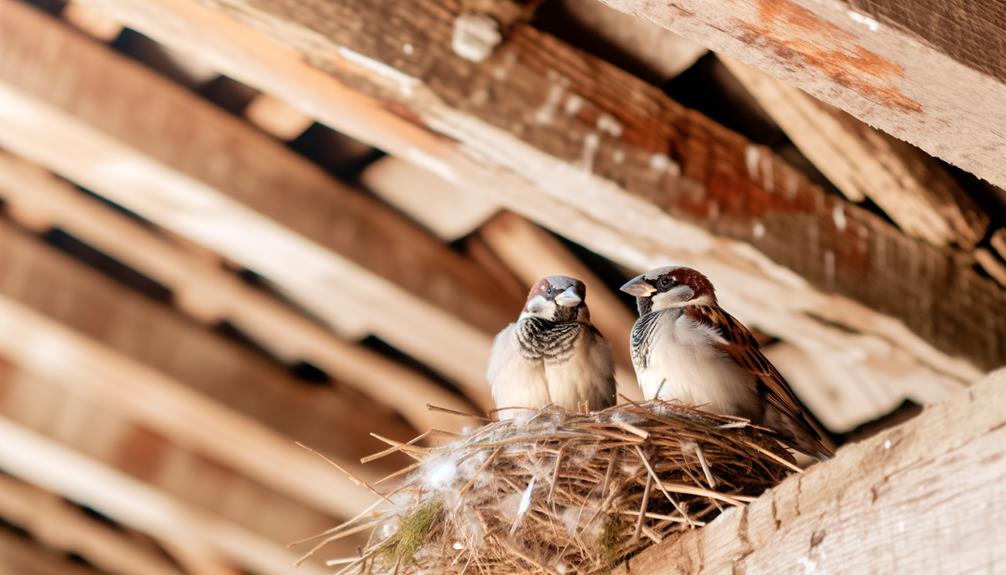
You'll observe that barn sparrows engage in a meticulous mate selection process influenced by plumage and song quality.
Both mates share nest responsibilities, including constructing the nest and feeding the chicks.
Research shows that this cooperative behavior increases offspring survival rates.
Mate Selection Process
In the mate selection process of barn sparrows, males often display colorful plumage and perform elaborate courtship rituals to attract potential mates. These behaviors aren't just for show; they're crucial for signaling fitness and genetic quality.
You can observe males vigorously defending their territory and singing intricate songs. Females then assess these displays to choose a suitable partner.
- Colorful plumage: Male sparrows' vivid feathers are a sign of good health.
- Elaborate courtship dances: These dances demonstrate the males' agility and strength.
- Territorial defense: Males rigorously guard their chosen area, indicating their ability to provide safety.
- Musical songs: Intricate songs suggest cognitive abilities and overall well-being.
- Nesting material offerings: Males often present potential nesting materials as a sign of resourcefulness.
Shared Nest Responsibilities
Once a pair of barn sparrows forms a bond, both mates actively participate in the construction and maintenance of their nest. You'll observe that each sparrow has specific roles: males often collect the bulk of the nesting materials, such as twigs and grasses, while females typically focus on arranging and weaving these materials into a cohesive structure.
Studies have shown that this division of labor enhances nest durability and increases the likelihood of successful offspring rearing. Moreover, both parents share incubation duties and provisioning of the chicks. This cooperative effort guarantees that the nest remains secure and that the young receive adequate care.
Nest Construction
Barn sparrows meticulously gather twigs, grasses, and feathers to construct their nests, ensuring a sturdy and insulated environment for their offspring. You'll find these industrious birds weaving their materials with precision, creating a well-engineered structure that offers protection from predators and harsh weather. The nests are often located in sheltered areas, like barn eaves or tree cavities, optimizing safety and accessibility.
Consider the impact of their dedicated efforts:
- Safety: Ensuring their young are protected from predators.
- Warmth: Providing insulation against the cold.
- Comfort: Creating a soft, secure place for eggs and chicks.
- Resilience: Building strong nests that withstand environmental challenges.
- Renewal: Continuously repairing and reinforcing their homes.
Their meticulous nest-building underscores the importance of providing a secure, nurturing space for future generations.
Observing Nesting Patterns
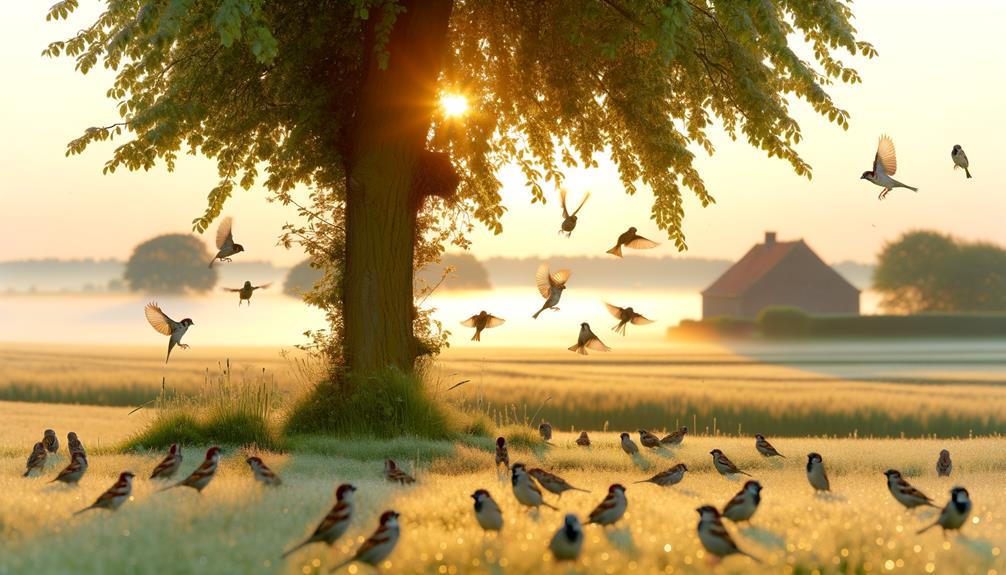
Understanding the complex patterns of barn sparrow nesting behaviors can reveal much about their survival strategies and reproductive success.
You'll observe that barn sparrows exhibit site fidelity, often returning to the same nesting sites year after year. This behavior maximizes their reproductive efficiency by utilizing familiar and previously successful locations.
Detailed studies show that sparrows prefer sites with ideal shelter and food availability, contributing significantly to fledgling survival rates.
By monitoring nesting cycles, you can discern peak breeding periods, generally in late spring and summer.
Observing these patterns not only highlights the adaptability of barn sparrows but also provides essential data for supporting their habitats.
Your role in documenting these behaviors aids in understanding and preserving these resilient birds.
Conservation Efforts
To effectively conserve barn sparrows, you must implement evidence-based strategies that address habitat preservation and food resource management. Ensuring their survival requires focused actions based on scientific observations and data.
Protecting nesting sites and maintaining insect populations, their primary food source, are essential steps. You should also advocate for policies that reduce pesticide use and promote ecological farming.
- Restoring natural habitats: Create green spaces where sparrows can thrive.
- Reducing pesticide use: Advocate for organic farming practices.
- Monitoring populations: Participate in citizen science projects to track sparrow numbers.
- Providing nesting boxes: Install artificial nests to offset habitat loss.
- Educating communities: Raise awareness about the importance of barn sparrows.
Conclusion
You'll find barn sparrows' nesting habits fascinating. Their homing instinct is like a magnetic pull, guiding them back to familiar sites. With nest site fidelity, they often return to the same cozy home, year after year.
Observe their seasonal behaviors closely; it's a dance of nature. Their meticulous nest construction showcases their dedication. Preservation efforts guarantee these tiny architects continue thriving.
So, keep your binoculars ready and witness the marvel of barn sparrows' nesting rituals.

